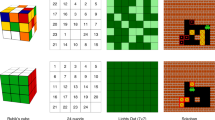Abstract
The autodidactic iteration algorithm was designed in hopes of finding an approximate solution to combinatorial optimization puzzles such as the prediction of protein tertiary structures. The prediction of protein tertiary structures allows a better understanding of its function in an organism. The Rubik’s cube is selected as a placeholder for the combinatorial optimization puzzle to represent the protein tertiary structures. The autodidactic iteration algorithm is used in environments with large state spaces and sparse rewards such as combinatorial puzzles like the Rubik’s cube. This research to solve a classic Rubik’s cube using the implementation of the autodidactic iteration algorithm is a reinforcement learning algorithm that can teach itself to solve the Rubik’s cube without human assistance. A neural network model is then trained to solve a scrambled Rubik’s cube while implementing Keras as the deep learning library. The Rubik’s cube is generated in a graphical user interface, GUI using Magic Cube. The Rubik’s cube generated in the GUI can be interacted with by turning the faces of the Rubik’s cube and changing the viewing angle of the Rubik’s cube. The interactive Rubik’s cube then uses the neural network model trained based on the model trained to solve a scrambled Rubik’s cube.
Access this chapter
Tax calculation will be finalised at checkout
Purchases are for personal use only
Similar content being viewed by others
References
Zhang Jingfen, H.Z.Q.W.: Functional Genomics. Methods Mol. Biol. 815(2), 3–13, 13 3 (2012)
Shmakov, S.M.A.A.: Solving the Rubik’s cube without human knowledge. University of California, Irvine, California (2018)
Williams, R.J.: Simple statistical gradient-following algorithms for connectionist reinforcement learning. Mach. Learn. 109(3), 5–32 (2020)
Cappel, L.M.: What is the difference between Deep Learning and Reinforcement Learning?. BIGDATA-MADESIMPLE, 1 March 2019. [Online]. Available: https://bigdata-madesimple.com/what-is-the-difference-between-deep-learning-and-reinforcement-learning/. Accessed 2020
Choudhary, A.: Reinforcement Learning: Introduction to Monte Carlo Learning using the OpenAI Gym Toolkit. Analytics Vidhya, 26 12 2018. [Online]. Available: https://www.analyticsvidhya.com/blog/2018/11/reinforcement-learning-introduction-monte-carlo-learning-openai-gym/?utm_source=blog&utm_medium=introduction-deep-q-learningp-ython. Accessed 2020
Li, Y.: Deep reinforcement learning: an overview. Introducing Deep Reinforcement Learning 16(10), 14–46 (2018)
Coulom, R.: Efficient selectivity and backup operators in monte-carlo tree search. In: International Conference on Computers and Games, Turin, Italy, 2006
Pierre Baldi, F.A.: Solving the Rubik’s cube with approximate policy iteration. In: International Conference on Learning Representations (ICLR), New Orleans, Louisiana, 2019
Agostinelli, F., McAleer, S., Shmakov, A., Baldi, P.: Solving the Rubik’s cube with deep reinforcement learning. Nat. Mach. Intell. 1, 356–362, 5 8 (2019)
Author information
Authors and Affiliations
Editor information
Editors and Affiliations
Rights and permissions
Copyright information
© 2022 The Author(s), under exclusive license to Springer Nature Singapore Pte Ltd.
About this paper
Cite this paper
Wen, K.Y.K., Wahab, M.N.A., Seng, Y.W., Chuan, W.C. (2022). Unraveling the Rubik’s Cube with Autodidactic Iteration Algorithm. In: Mahyuddin, N.M., Mat Noor, N.R., Mat Sakim, H.A. (eds) Proceedings of the 11th International Conference on Robotics, Vision, Signal Processing and Power Applications. Lecture Notes in Electrical Engineering, vol 829. Springer, Singapore. https://doi.org/10.1007/978-981-16-8129-5_54
Download citation
DOI: https://doi.org/10.1007/978-981-16-8129-5_54
Published:
Publisher Name: Springer, Singapore
Print ISBN: 978-981-16-8128-8
Online ISBN: 978-981-16-8129-5
eBook Packages: Intelligent Technologies and RoboticsIntelligent Technologies and Robotics (R0)




